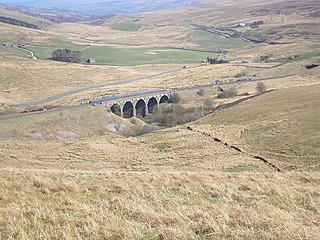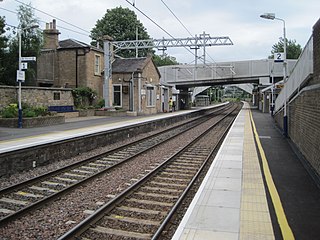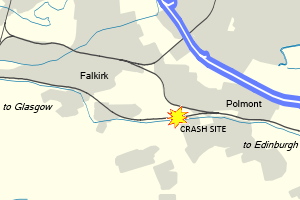Related Research Articles

The Quintinshill rail disaster was a multi-train rail crash which occurred on 22 May 1915 outside the Quintinshill signal box near Gretna Green in Dumfriesshire, Scotland. It resulted in the deaths of over 200 people and remains the worst rail disaster in British history.

The Hawes Junction rail crash occurred at 5.49 am on 24 December 1910, just north of Lunds Viaduct between Hawes Junction and Aisgill on the Midland Railway's Settle and Carlisle main line in the North Riding of Yorkshire, England. It was caused when a busy signalman, Alfred Sutton, forgot about a pair of light engines waiting at his down (northbound) starting signal to return to their shed at Carlisle. They were still waiting there when the signalman set the road for the down Scotch express. When the signal cleared, the light engines set off in front of the express into the same block section. Since the light engines were travelling at low speed from a stand at Hawes Junction, and the following express was travelling at high speed, a collision was inevitable. The express caught the light engines just after Moorcock Tunnel near Aisgill summit in Mallerstang and was almost wholly derailed.

The Charfield railway disaster was a fatal train crash which occurred on 13 October 1928 in the village of Charfield in the English county of Gloucestershire. The London, Midland and Scottish Railway (LMS) Leeds to Bristol night mail train failed to stop at the signals protecting the down refuge siding at Charfield railway station. The weather was misty, but there was not a sufficiently thick fog for the signalman at Charfield to employ fog signalmen. A freight train was in the process of being shunted from the down main line to the siding, and another train of empty goods wagons was passing through the station from the Bristol (up) direction.
The Edinburgh and Glasgow Railway was authorised by act of Parliament on 4 July 1838. It was opened to passenger traffic on 21 February 1842, between its Glasgow Queen Street railway station and Haymarket railway station in Edinburgh. Construction cost £1,200,000 for 46 miles (74 km). The intermediate stations were at Corstorphine, Gogar, Ratho, Winchburgh, Linlithgow, Polmont, Falkirk, Castlecary, Croy, Kirkintilloch and Bishopbriggs. There was a ticket platform at Cowlairs. The line was extended eastwards from Haymarket to North Bridge in 1846, and a joint station for connection with the North British Railway was opened on what is now Edinburgh Waverley railway station in 1847.

The Harrow and Wealdstone rail crash was a three-train collision at Harrow and Wealdstone station in Wealdstone, Middlesex during the morning rush hour of 8 October 1952. The crash resulted in 112 deaths and 340 injuries, 88 of these being detained in hospital. It remains the worst peacetime rail crash in British history and the second deadliest overall after the Quintinshill rail disaster of 1915.

The 1892 Thirsk rail crash happened at Manor House signal box on 2 November 1892, on the North Eastern Railway about 3 miles (4.8 km) north of Thirsk railway station in the North Riding of Yorkshire, England.

Polmont railway station is a railway station serving the village of Polmont, Scotland as well as the other Falkirk Braes villages. It is located on the Glasgow to Edinburgh via Falkirk Line and is also served by ScotRail services from Edinburgh to Stirling and Dunblane. It is the nearest station to much of the town of Grangemouth.

Larbert railway station is a railway station serving Larbert near Falkirk, Scotland.

The Polmont rail accident, also known as the Polmont rail disaster, occurred on 30 July 1984 to the west of Polmont, near Falkirk, in Scotland. A westbound push–pull express train travelling from Edinburgh to Glasgow struck a cow which had gained access to the track through a damaged fence from a field near Polmont railway station, causing all six carriages and the locomotive of the train to derail. 13 people were killed and 61 others were injured, 17 of them seriously. The accident led to a debate about the safety of push–pull trains on British Rail.

Cumbernauld railway station serves the town of Cumbernauld in North Lanarkshire, Scotland. The station is managed by ScotRail and is located on the Cumbernauld Line, 14 miles (23 km) north east of Glasgow Queen Street station and the Motherwell to Cumbernauld Line, 11+3⁄4 miles (18.9 km) north of Motherwell. Trains serving the station are operated by ScotRail.
Two rail accidents have occurred near Castlecary, Scotland. One of these was in 1937 and one in 1968. Both events involved rear-end collisions, and caused the deaths of 35 and 2 people respectively.
The Scottish Central Railway was formed in 1845 to link Perth and Stirling to Central Scotland, by building a railway line to join the Edinburgh and Glasgow Railway near Castlecary.

Bo'ness railway station is a heritage railway station in Bo'ness, Falkirk, Scotland. It is not the original Bo'ness railway station, which was located roughly a quarter mile west on Seaview Place, now the site of a car park.
The Monkland Railways was a railway company formed in 1848 by the merger of three "coal railways" that had been built to serve coal and iron pits around Airdrie in Central Scotland, and connect them to canals for onward transport of the minerals. The newly formed company had a network stretching from Kirkintilloch to Causewayend, near Linlithgow. These coal railways had had mixed fortunes; the discovery of blackband ironstone and the development of the iron smelting industry around Coatbridge had led to phenomenal success, but hoped-for mineral discoveries in the moorland around Slamannan had been disappointing. The pioneering nature of the railways left them with a legacy of obsolete track and locomotives, and new, more modern, railways were being built around them.
The Slamannan and Borrowstounness Railway was a railway built in Scotland in 1848 to extend the Slamannan Railway to the harbour at Borrowstounness on the Firth of Forth, and to connect with the Edinburgh and Glasgow Railway. It was not commercially successful, but in recent years part of it was taken over by the Scottish Railway Preservation Society, which operates the Bo'ness and Kinneil Railway.

Ditton Junction is near Widnes on the Liverpool spur of the former London and North Western Railway. This complex junction had eight running lines and associated signal gantries. On 17 September 1912 the 17:30 Chester to Liverpool express was signalled to cross from the fast to the slow line, but the driver, Robert Hughes, age 41, from Llangwstenin, Conwy, who had little experience of the junction and had never been switched here before, misread the signals and thought he had a clear run through. The crossover had a speed limit of 15 mph but the train hit it at 60 mph. The locomotive, a 2-4-0 of the Precedent class turned on its side and travelled some distance, striking the pier of an overbridge and breaking in two. The six carriages following ploughed over the engine and were all destroyed - forming a heap of wreckage between the station platforms. Punctured gaslighting cylinders ignited, turning the scene into an inferno. The driver, fireman and 13 passengers were killed.
The Kirtlebridge rail crash took place in 1872 at Kirtlebridge railway station in Dumfriesshire. An express passenger train ran into a goods train that was shunting; 11 people lost their lives immediately, and one further person succumbed later. The cause was a failure to communicate between the station master in charge of the shunting operation, and the signalman. There was not full interlocking of the points, and the block system of signalling was not in use.
Manuel Junction is a railway junction near the village of Whitecross, Falkirk, Scotland. It is the terminus of the Bo'ness and Kinneil Railway and forms a connection between it and the Glasgow–Edinburgh via Falkirk line.
The Dumfries, Lochmaben and Lockerbie Railway was a railway in Dumfriesshire, Scotland. It connected Dumfries with Lockerbie via Lochmaben. Promoted independently, it was absorbed by the Caledonian Railway to give access to Dumfriesshire and later to Portpatrick for the Irish ferry service. It opened in 1863, closed to ordinary passenger services in 1952, and closed completely in 1966.
References
Notes
- ↑ Rolt, 1982: pp. 64–67
Sources
- Rolt, L. T. C.; Kichenside, G. M. (1982). Red for Danger: A history of railway accidents and railway safety (4th ed.). Newton Abbot, Devon: David & Charles. ISBN 0-7153-8362-0. OCLC 9526651.